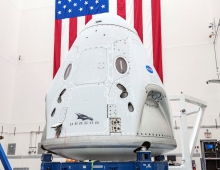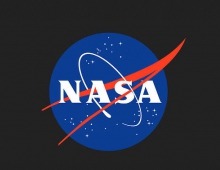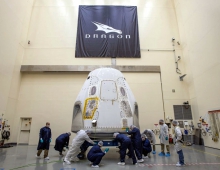
NASA Awards Contract to Deliver Tech to Moon, Selects Early-Stage Technology Concepts
NASA has selected Masten Space Systems of Mojave, California, to deliver and operate eight payloads – with nine science and technology instruments – to the Moon’s South Pole in 2022, to help lay the foundation for human expeditions to the lunar surface beginning in 2024.
The payloads, which include instruments to assess the composition of the lunar surface, test precision landing technologies, and evaluate the radiation on the Moon, are being delivered under NASA’s Commercial Lunar Payload Services (CLPS) initiative as part of the agency’s Artemis program.
In 2024, the Artemis 3 mission will touchdown at the Moon’s South Pole. The female and one male astronaut will become the first moonwalkers of the 21st century, 55 years after Apollo 17 blasted-off.
Although Artemis 3 is planned to include only a brief visit to the lunar surface, NASA has grander plans for future Artemis missions in the late 2020s.
Future astronauts will need to be able to locate and collect lunar resources, and then transform them into the essentials for life, such as breathable air, water for drinking and food production, building materials for shelter and rocket propellants.
“Under our Artemis program, we are going to the Moon with all of America,” said NASA Administrator Jim Bridenstine. “Commercial industry is critical to making our vision for lunar exploration a reality. The science and technology we are sending to the lunar surface ahead of our crewed missions will help us understand the lunar environment better than we ever have before. These CLPS deliveries are on the cutting edge of our work to do great science and support human exploration of the Moon. I’m happy to welcome another of our innovative companies to the group that is ready to start taking our payloads to the Moon as soon as possible.”
The $75.9 million award includes end-to-end services for delivery of the instruments, including payload integration, launch from Earth, landing on the Moon’s surface, and operation for at least 12 days. Masten Space Systems will land these payloads on the Moon with its XL-1 lander.
The payloads that will be delivered have been developed predominantly from the two recent NASA Provided Lunar Payloads (NPLP) and Lunar Surface Instrument and Technology Payloads (LSITP) solicitations.
The nine instruments to be delivered are:
- Lunar Compact Infrared Imaging System (L-CIRiS) will deploy a radiometer – a device that measures infrared wavelengths of light – to explore the Moon's surface composition, map its surface temperature distribution, and demonstrate the instrument's feasibility for future lunar resource utilization activities.
- Linear Energy Transfer Spectrometer (LETS) is a sensor that will measure the radiation environment on the Moon’s surface. The payload also is being flown on a CLPS flight to the Moon in 2021.
- Heimdall is a flexible camera system for conducting lunar science on commercial vehicles. This innovation includes a single digital video recorder and four cameras: a wide-angle descent imager, a narrow-angle regolith imager, and two wide-angle panoramic imagers. This camera system is intended to model the properties of the Moon's regolith – the soil and other material that make up the top layer of the lunar surface – and characterize and map geologic features. Other goals for this instrument include characterizing potential landing or trafficability hazards.
- MoonRanger is a small robotic rover that weighs less than 30 pounds and will demonstrate communications and mapping technologies. It will demonstrate the ability to move quickly across long distances on the lunar surface with autonomous navigation and without the ability to communicate with Earth in real time. It is a technology that could enable exploration of destinations that are far from lunar landing sites. The MoonRanger will carry the Neutron Spectrometer System, which will measure the concentration of hydrogen in the Moon’s regolith – a possible indication of the existence of buried water.
- Mass Spectrometer Observing Lunar Operations (MSolo) is a device to measure potentially accessible resources on the Moon’s surface. It will identify gases coming off a lander during touchdown on the lunar surface to help scientists understand what elements are coming from the lunar surface and which ones are introduced by a lander itself.
- Near-Infrared Volatile Spectrometer System (NIRVSS) is a tool to measure surface composition and temperature. The instrument will characterize the variability of the lunar soils and detect volatiles such as methane, carbon dioxide, ammonia and water.
- Laser Retroreflector Array (LRA) is a series of eight small mirrors to measure distance and support landing accuracy. It requires no power or communications from the lander and can be detected by future spacecraft orbiting or landing on the Moon.
- Sample Acquisition, Morphology Filtering, and Probing of Lunar Regolith (SAMPLR) is a robotic arm that will collect samples of lunar regolith and demonstrate the use of a robotic scoop that can filter and isolate particles of different sizes. The sampling technology makes use of a flight spare from the Mars Exploration Rover project.
NASA has contracted with 14 American companies to deliver science and technology to the lunar surface through competed task orders. The agency plans to issue at least two such task orders per year through which the companies can propose to take payloads to the Moon. Under the Artemis program, early commercial deliveries of payloads to the lunar surface missions enable NASA to perform science experiments, test technologies and demonstrate capabilities to further explore the Moon and prepare for human missions.
In May 2019, NASA selected two CLPS providers, Astrobotic and Intuitive Machines, who are each making progress toward sending payloads to the Moon next year. In February, NASA asked the 14 companies to provide proposals to fly the Volatiles Investigating Polar Exploration Rover (VIPER), which will be the first rover on the Moon that will look for and map the distribution of water and other important volatiles at one of the lunar poles. In addition to these deliveries and the delivery to be made by Masten Space Systems, payloads for a fifth lunar delivery are in development, and NASA will soon be initiating a new series of payload acquisitions for targeted science investigations for years to come.
Early-Stage Technology Concepts
Future technologies that could enable quicker trips to Mars and robotic exploration of ocean worlds might have started out as NASA Innovative Advanced Concepts (NIAC).
The program, which invests in early-stage technology ideas from NASA, industry and academic researchers across the United States, has selected 23 potentially revolutionary concepts with a total award value of $7 million.
Among the selections are 16 new concepts and seven studies that previously received at least one NIAC award. A full list of the 2020 Phase I, II and III selections can be found here.
http://www.nasa.gov/directorates/spacetech/niac/2020_Phase_I_Phase_II
“NIAC is an innovative program that encourages researchers – and the agency – to think outside of the box for solutions that could overcome challenges facing future science and exploration missions,” said Walt Engelund, deputy associate administrator for programs within NASA’s Space Technology Mission Directorate (STMD). “We’re excited about the new concepts and to see how additional time and resources advances the research selected for follow-on Phase II and III studies.”
A mission concept to image Earth-like planets outside of the solar system was selected for a Phase III study. Slava Turyshev, a researcher at NASA’s Jet Propulsion Laboratory in Pasadena, California, will receive a $2 million grant to further mature the concept and related technologies.
During his Phase I and Phase II NIAC research, Turyshev outlined the feasibility of a solar gravity lens to enable enhanced viewing of planets orbiting other stars, known as exoplanets. He also developed a mission architecture that uses multiple small spacecraft and solar sail technology to propel them to their target destination 50 billion miles from Earth.
“This is only the third study selected for Phase III funding in the history of the program,” said NIAC Program Executive Jason Derleth. “We’re excited by its potential to bring us closer to imaging an exoplanet in detail, at a resolution comparable to the well-known Apollo 8 Earthrise photo.”
The selected Phase I and II studies will explore the overall viability of a technology and develop them into mission concepts. Areas researchers will study include mapping asteroids and other small bodies in the solar system with hopping probes, making on-demand pharmaceuticals in space, and extracting water on the Moon. Several of the concepts could inform capabilities relevant to NASA’s Artemis program, which will land the first woman and next man on the Moon in 2024 and establish a sustainable presence on and around the Moon by 2028.
All the selected projects are still in the early stages of development, with most requiring a decade or more of technology maturation, and are not official NASA missions.
Selected Phase II researchers receive $500,000 grants to further develop their concepts for up to two years. Phase III is designed to strategically transition NIAC concepts with the highest potential impact for NASA other government agencies or commercial partners. Phase III researchers receive $2 million grants to develop and mature their mission concept over two years.





















